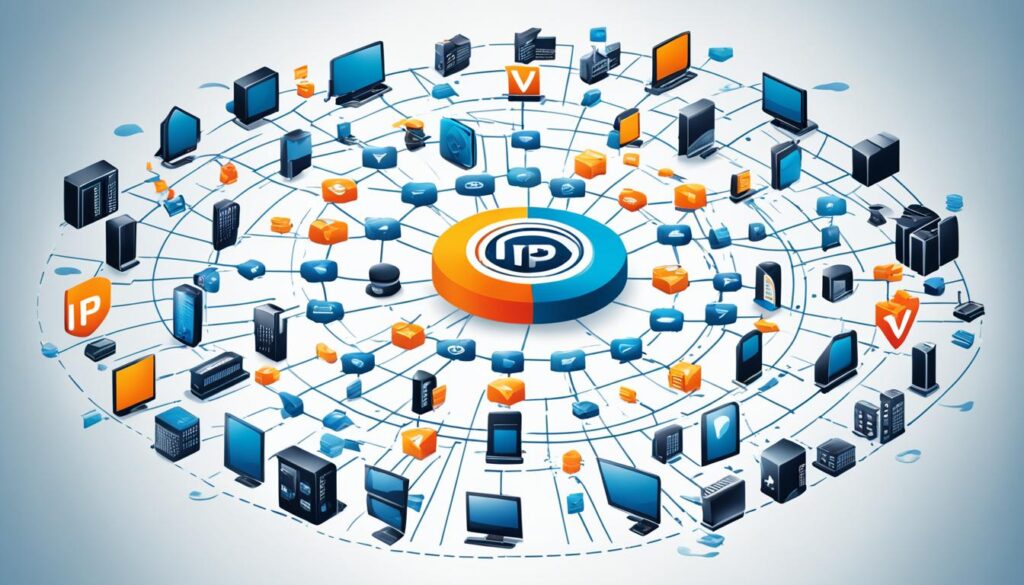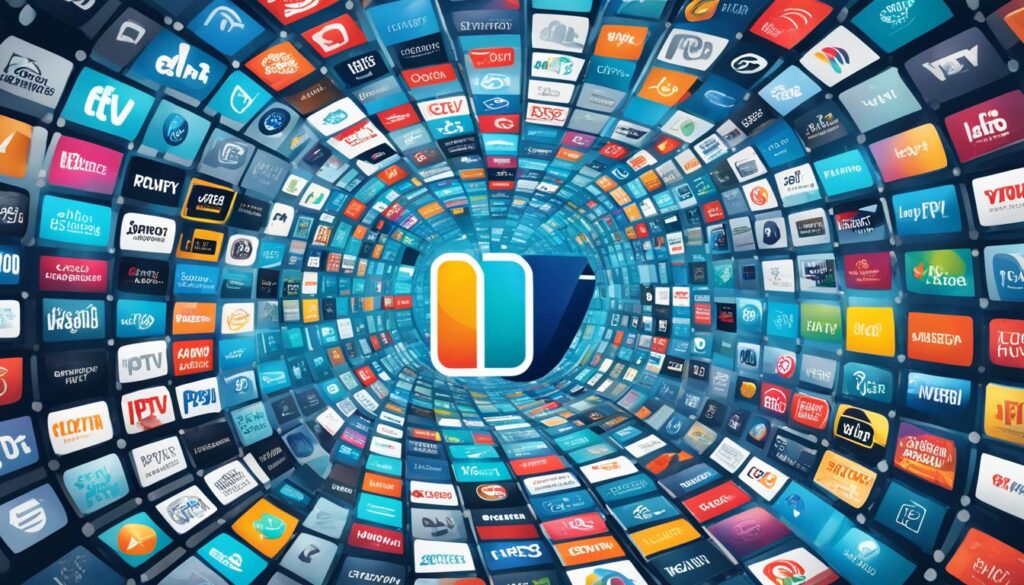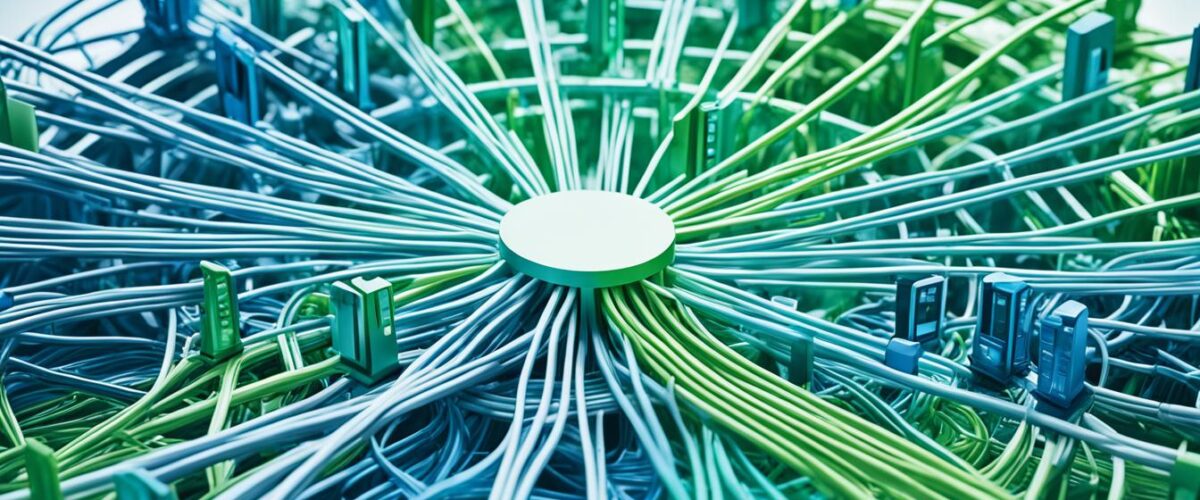Do you watch TV through IPTV? It’s quickly becoming the top way people enjoy media. Thanks to streaming services and the need for online content, Internet Protocol Television has changed how we consume TV and videos. The key to this smooth experience is the network infrastructure supporting IPTV.
Key Takeaways:
- IPTV is revolutionizing media consumption through digital content delivery.
- Network infrastructure plays a crucial role in delivering high-quality streaming services.
- Understanding the intricate network architecture is essential to appreciate the complexity of IPTV.
- Technological advancements underpin the success of IPTV.
- Optimizing network infrastructure enables seamless, high-quality streaming experiences.
The Network Architecture of IPTV
IPTV’s network architecture is essential for sending multimedia over the internet. It’s different from traditional TV methods because it uses the internet. This way is cheaper and can grow easily. The main parts of this system are content servers, middleware, streaming rules, and the gadgets you watch from.
To see how IPTV works, we’ll break down each piece.
Content Servers:
Content servers keep and look after the shows and movies. They have lots to choose from, including live shows and catch-up TV. This gives everyone something they will like.
Middleware:
Middleware connects the servers to your gadget. It makes sure only you can see your shows securely. It also lets you navigate through what’s available. You can see times for shows and pick what to watch whenever you want.
Streaming Protocols:
Streaming rules help send the shows to you without problems. They work together to make sure the picture and sound match up. This makes watching smooth and enjoyable.
Client Devices:
Your gadget is where you see everything. It can be a TV, a phone, or even a tablet. They understand the rules and show your show correctly. This makes watching TV easy wherever you are.
This setup makes getting TV shows and movies fun and easy for everyone. All the parts work together to make a great watching experience. You get to see what you like, when you like.
The Role of Content Delivery Networks (CDNs) in IPTV
Content Delivery Networks (CDNs) are key to better multimedia content distribution in IPTV systems. They consist of servers spread worldwide. This allows for efficient delivery of multimedia content to viewers. Popular content is cached closer to users. This reduces delays, buffers less, and boosts streaming quality.
CDNs store copies of multimedia content on many servers worldwide. When a user wants content, the closest server delivers it. This decreases how far data has to travel, cutting down on delays. Also, they can pick servers with less traffic. This keeps delivery fast and reliable.
With smart caching, CDNs make sure users get uninterrupted IPTV. They store copies of files near users, making it quicker to reach them. This improves the quality of streaming for everyone.
CDNs also make sure IPTV can handle many viewers at once without problems. By using many servers, they spread out the load. This stops one server from being overwhelmed and prevents outages. So, viewers enjoy a steady stream.
Moreover, CDNs spot when networks are too busy. They switch traffic to less busy servers. This keeps content flowing well, no matter how many are watching or the network state.
In the end, CDNs are essential for IPTV to work smoothly. They cache and distribute content well, lessening delays and offering great viewing. Their smart use of resources and management make networks for IPTV strong and reliable.

| Benefits | Description |
|---|---|
| Faster Content Delivery | CDNs reduce latency by caching and delivering content from servers closer to the end-users, minimizing the distance data travels. |
| Improved Streaming Performance | By reducing buffering and optimizing content distribution, CDNs enhance overall streaming performance, providing a smooth and uninterrupted viewing experience. |
| Scalability and Reliability | CDNs can handle high traffic volumes during peak periods by distributing content across multiple servers, ensuring system scalability and reliability. |
| Optimized Network Resources | CDNs detect network congestion and dynamically reroute traffic to less congested servers, optimizing content distribution and improving streaming performance. |
Streaming Protocols in IPTV
Streaming protocols are key for smooth IPTV content delivery over IP networks. They keep video quality high and in sync, no matter the network. Let’s look at the important ones used in IPTV:
1. Real-Time Streaming Protocol (RTSP)
RTSP is all about real-time multimedia delivery. It lets users control and watch videos and audios at the same time. This makes watching IPTV a great experience.
2. Real-Time Transport Protocol (RTP)
RTP sends audio and video packets across networks. It makes sure these packets arrive on time and in good condition. Thus, the content quality stays high throughout.
3. Hypertext Transfer Protocol (HTTP)
Although known for websites, HTTP is also vital for IPTV. It helps move media files through networks for smooth streaming.
There’s a tech called adaptive bitrate streaming too. It changes video quality to match network conditions. This keeps the video playing without any stops, even if the network is not stable.
| Streaming Protocol | Key Features |
|---|---|
| Real-Time Streaming Protocol (RTSP) | Enables synchronization and control of real-time multimedia streams. |
| Real-Time Transport Protocol (RTP) | Ensures reliable transmission of audio and video data packets. |
| Hypertext Transfer Protocol (HTTP) | Facilitates the transfer of media files for seamless streaming. |
| Adaptive Bitrate Streaming | Dynamic adjustment of video quality based on network conditions. |
These protocols, along with adaptive bitrate streaming, make IPTV a great experience. They ensure smooth play, excellent video quality, and work well even with different networks. This way, they meet the changing needs of IPTV users.
Middleware Solutions in IPTV
Middleware solutions are key in IPTV. They act as go-betweens for content providers and users. They allow for smooth content delivery and handle important tasks like user authentication and billing.
User Authentication and Session Control
They make sure only the right people access content by setting up secure logins. This stops content theft. They also let users move between devices easily while watching.
Content Encryption and Security
Middleware uses strong encryption to keep videos safe. This means users can’t watch content without permission. They use high-level security to protect content from pirates.
Electronic Program Guides and Video-On-Demand Catalogs
They offer user-friendly guides to find shows and more. Plus, they manage VOD catalogs, letting users pick what to watch, when they want.
Billing and Payment Systems
Middlewares make billing and payments smooth in IPTV. They track user spending and create clear bills. Users can pay easily and safely with different methods.
Interactive Advertising
They set up cool ads that are just for you. More engaging ads mean better content for users and more money for content-makers.
In short, middleware is vital in making IPTV work well. It ensures user safety and offers a great viewing experience. It helps with watching, paying, and finding what you want to see.

Encryption and Security in IPTV
IPTV systems take security seriously. They use strong encryption to keep content safe from piracy and theft. Techniques like DRM and CAS make sure multimedia content stays private and secure.
Authentication is crucial. It checks who users and devices are before they get IPTV access. This stops bad actors and adds a layer of protection.
Access controls also help a lot. They let only the right people see certain content. This keeps copyrighted material safe and stops it from spreading to those who shouldn’t see it.
Watermarking is an invisible way to mark content. It means you can trace back who should or shouldn’t have it. This stops people from sharing it in the wrong ways.
Ensuring Content Protection
Together, encryption, authentication, access controls, and watermarking make a safe environment. They guard against theft and piracy, keeping IPTV secure.
Encryption alone does a lot. It turns content into a secret code for only the rightful viewers. This way, content stays private and can’t be seen by the wrong people.
DRM is key for managing content rights. It controls who can see what based on rules. This helps avoid problems like letting the wrong people see the content or using it in the wrong way.
CAS manages premium content access. It uses both encryption and special cards or software. This makes sure only those who should see it actually do.
A Holistic Security Approach
To keep IPTV safe, many methods work together. Encryption, authentication, access controls, and watermarking combine forces. This approach keeps content safe from unauthorized use and piracy.
| Encryption and Security in IPTV | |
|---|---|
| Encryption Techniques | Protects content during transmission by encoding it and making it unreadable to unauthorized users. |
| Digital Rights Management (DRM) | Enforces usage rights and restrictions on digital content to ensure authorized viewing. |
| Conditional Access Systems (CAS) | Controls decryption and access of premium content to authorized users with valid credentials. |
| Authentication Mechanisms | Verifies the identity of users and devices, preventing unauthorized access. |
| Access Controls | Restricts access to authorized individuals, preventing unauthorized viewing and redistribution. |
| Watermarking Technologies | Embeds invisible markers in content for source identification and tracing, deterring unauthorized distribution. |
Scalability and Redundancy in IPTV
Scalability and redundancy matter a lot in IPTV. They make sure service keeps going without a hitch, stays available, and streams are always reliable. With strong server setups, balancing the load, and backup systems, IPTV companies can stay online through any issue and meet changing demand easily.
Server Architectures and Load Balancing
IPTV uses multiple servers to share the work and not waste any resources. If one server fails, others pick up the slack immediately, keeping everything online and working well. To handle many users and keep streaming smooth, systems send user requests to the server with less traffic, not letting any one server get too busy.
Failover Systems for Continuous Service
Failover systems are key in IPTV. They switch users over to backup servers fast if one fails, so streaming never stops. By acting fast when problems occur, IPTV services promise to be always available, keeping everyone watching without pause.
Cloud-Based Deployment Models for Scalability
Cloud systems have changed how IPTV grows. They help add or take away resources exactly when needed, keeping service top-notch even during the busiest times. This flexibility makes it easier to manage servers and keep up with demand without affecting quality.
| Key Benefits | Scalability | Redundancy | Availability | Reliability |
|---|---|---|---|---|
| Improves capacity to handle increased streaming demand | Reduces the risk of service interruptions | Ensures continuous service delivery in the event of server failures | Minimizes downtime and disruptions for end-users | Enhances overall streaming experience and user satisfaction |
IPTV success depends on being ready for more users while always keeping streams stable. With powerful servers, smart load sharing, backup plans, and cloud support, viewers around the world enjoy a reliable watch-anytime experience.

The Importance of Networking Hardware in IPTV
Investing in top-notch networking hardware is key for better IPTV streaming. A strong router is needed, especially one that supports Wi-Fi 6 and QoS. This kind of router can make your IPTV streams smoother and faster.
For the best connection, use Ethernet instead of Wi-Fi. Wired connections are more reliable. Also, tools like CDNs and network monitoring can make your streaming even better.
Router: The router is like the heart of your IPTV setup. It connects your gadgets to the web and manages how data moves. A good model supports Wi-Fi 6, making sure you get the best of your high-def IPTV.
Quality of Service (QoS): QoS in your router can be a game-changer. It lets you put IPTV first, making sure it runs smoothly. This means less buffering or lag when watching your favorite shows.
Wired Connections: Going wired with Ethernet is best for IPTV. It’s more reliable than Wi-Fi and keeps your streams steady. So, if you want smooth watching, use an Ethernet cable.
Content Delivery Networks (CDNs): CDNs help by storing and sending out IPTV content from servers close to you. They improve speed and quality by cutting down on how far the data has to travel to get to you. This makes for a less glitchy watching experience.
Network Monitoring: Keeping an eye on your network’s health is smart. Monitoring tools can catch and fix problems before your shows start to buffer. They keep your stream flowing without any hitches.
Security Measures: Protecting your network with firewalls and strong passwords is a must. Adding a VPN is even better as it hides your web activity, keeping you safe while you stream.
Focusing on good networking gear, the right features, and security can help you get the most from your IPTV. It’s all about making your streaming experience top-notch.
IPTV Use Cases and Providers
IPTV stands for Internet Protocol Television. It combines well with other IP-based services like voice over IP and fast internet. This lets users enjoy smooth streaming and a wide range of content.
Video on Demand
Video on demand (VoD) is a favorite IPTV feature. It lets users pick and stream from a huge collection of movies, shows, and videos whenever they want. IPTV’s interactive tools also let users search, stop, rewind, or skip parts of shows easily. This makes watching more personal and engaging.
Interactive TV
Interactive TV is exciting with IPTV. Viewers can chat live, take part in polls, and use social media while watching. This turns watching TV into a shared experience. People can talk about their favorite shows with others and even influence what happens next in some programs.
Livestreaming
Livestreaming through IPTV means you can watch events, sports games, or concerts as they happen, no matter where you are. This brings the excitement of live shows right to your screen, making every moment thrilling.
Internet TV
Internet TV is all about watching TV shows and movies over the internet. IPTV is key in this area, serving content over the web instead of through traditional broadcasts. This opens up a world of channels and services for users to choose from. It’s no wonder internet TV is becoming more and more popular globally.
Leading companies in the IPTV scene are Verizon, Netflix, Google, and Apple. They are well-known for their rich content offerings and reliable streaming services. These giants shape the market thanks to their wide range of content and solid streaming tech.
But there are also smaller firms, focusing on certain types of content and distribution. They may spotlight things like sports, documentaries, or content from specific regions. This allows niche audiences to find exactly what they are looking for in an IPTV service.
In all, IPTV offers many ways to enjoy TV shows and videos. Whether through on-demand features, interacting with favorite shows, or catching the latest events live, it changes how we consume media. IPTV provides an innovative mix of choices and interactive features for a rich viewing experience.

| Major IPTV Providers | Smaller Niche Companies |
|---|---|
| Verizon | SportsTV |
| Netflix | DocuStream |
| RegionalTV | |
| Apple | EntertainmentPlus |
Embracing the Future of IPTV with Network Infrastructure
Network infrastructure is key in making IPTV better. As more people use internet TV, having a strong network is essential. It makes sure the shows and movies stream well.
For IPTV to work, good bandwidth is needed. This makes content delivery fast and smooth. By upgrading to latest tech, IPTV services can show high-quality videos without any problems.
Having a stable network stops shows from stopping or getting blurry. A strong network keeps videos playing smoothly. This lets viewers watch without any issues.
To keep offering top-notch streams, IPTV companies must update their networks. They add new hardware and use advanced tech. This makes sure the viewing experience is great for everyone.
Optimizing Bandwidth for High-Quality Streaming
Making good use of bandwidth is key as more people want HD and 4K videos. With smart compression and streaming methods, IPTV can meet this need. It makes videos look great without using too much of the network.
Also, Content Delivery Networks (CDNs) store and share media closer to viewers. This shortens the distance data travels. The result is faster videos and less buffering for people watching.
Ensuring Network Stability for a Seamless Experience
A steady network is vital for IPTV to work well. IPTV companies use backup systems to keep things running, even if something goes wrong. These measures help avoid long pauses in service.
Tech that keeps an eye on the network also helps. It fixes issues before they become a problem. This means better performance and happier viewers.
Investing in Network Infrastructure for the Future
The future of IPTV demands strong network systems. To meet viewers’ high standards, networks must keep growing. Using the latest hardware and the cloud, IPTV can grow without hiccups.
The cloud’s flexibility is a huge plus. It lets operators adjust quickly to their audience’s needs. This way, viewers get a great watching experience, no matter how many are online.
Enhancing the Streaming Experience with Network Infrastructure
Improving the network is crucial for great IPTV. It ensures smooth streaming, less buffering, and amazing videos. These are the pillars of an engaging watching experience.
Looking ahead with IPTV means understanding the role of good networks. Enough bandwidth, a stable network, and constant updates are needed. This is how IPTV keeps satisfying viewers.
| Advantages of Optimized Network Infrastructure | Challenges of Inadequate Network Infrastructure |
|---|---|
|
|
Conclusion
Network infrastructure is key in the IPTV world. It uses complex designs, methods to deliver content, and security to shape TV and streaming. By improving this infrastructure, adapting to new tech, and focusing on user needs, IPTV changes how we watch media.
Technology growth brings us closer through media. IPTV lets viewers smoothly watch high-quality shows on their devices. This new way opens many doors for creators, broadcasters, and users to connect in fresh, fun ways.
IPTV is always getting better, needing faster, stronger networks to keep up. To stay ahead, we must strengthen our networks and welcome new ideas. This way, IPTV can lead the media world, offering amazing streaming to everyone.
FAQ
What is IPTV?
How does IPTV work?
What is the role of Content Delivery Networks (CDNs) in IPTV?
Which streaming protocols are used in IPTV?
What are middleware solutions in IPTV?
How is security ensured in IPTV systems?
How does IPTV infrastructure ensure scalability and reliability?
What networking hardware is important for IPTV?
What are some IPTV use cases and providers?
Why is network infrastructure important for IPTV?





